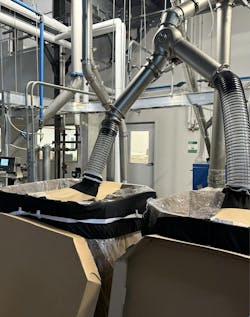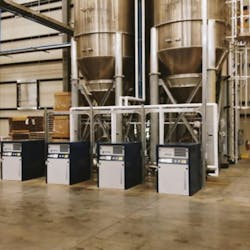Premix Transforms its Conductive Polymer Manufacturing with AI and Automation
- Premix's new facility in North Carolina features end-to-end automation to provide real-time monitoring of critical parameters like melt temperature, carbon black dispersion and electrical conductivity.
- The company’s in-house AI/ML system trained on more than 20,000 historical polymer recipes to provide instant material property predictions, rank existing formulations and generate thousands of virtual formulations, reducing development cycles from months to days.
- AI-generated recipes are automatically translated into production control setpoints, real-time sensor data feeds back into the AI database to refine future predictions and test results continuously enhance model accuracy.
When Premix Group decided to establish its first U.S. manufacturing presence, the Finnish specialty chemicals company saw an opportunity to reimagine how conductive polymer compounds are produced. In June 2025, the company officially inaugurated its facility at Apple Creek Corporate Center outside Charlotte, N.C. — a plant that represents a convergence of four decades of materials expertise with Industry 4.0 automation and artificial intelligence.
The facility produces conductive polymer compounds for applications across the medical, automotive, defense, electronics and packaging markets.
But what sets this operation apart isn't just its strategic importance in bringing supply chain resilience to North American customers, it’s the company’s focus on using advanced automation to assist its customers with compound formulation and production to support their extrusion and injection molding applications.
Premix has also implemented Lean Six Sigma methodologies throughout the operation. Operators are trained as Lean Six Sigma practitioners, creating a culture of continuous improvement that complements the high-tech systems.
Automation from raw materials to finished goods
With the plant being designed around the principle of minimal human intervention in the manufacturing process, Eric Madeck, maintenance, equipment and systems manager at Premix, explained the scope of the automation: "We have automated conveying from raw materials all the way through to finished goods. We are using Allen Bradley PLCs and MachineView software to convey, dose and homogenize the products. The only manual handling of material in our process is hoisting carbon black super sacks to the second level and changing out gaylords [large, sturdy cardboard boxes used for storing and transporting bulk items] when they are empty."
Though high levels of automation are central to the operation of this new facility, Premix has also implemented Lean Six Sigma methodologies throughout the operation. Operators are trained as Lean Six Sigma practitioners, creating a culture of continuous improvement that complements the high-tech systems.
The plant features modern extruders and mixers equipped with real-time sensing capabilities that monitor critical parameters including melt temperature, carbon black dispersion, throughput rates, viscosity and electrical conductivity performance. These automated control systems ensure consistency across large production batches.
"All of our equipment is integrated with a PLC program written with direction from Premix, equipment supplier Coperion and engineering services company Petronik," Madeck said. "And all processes in our facility are controlled through a centralized computer in the control room or an iPad that can be used anywhere in the factory.
The connected conveyor systems integrate directly with the PLCs to synchronize material feeding, conveying and packaging operations. This automated transfer of raw materials — including polyethylene, polypropylene and carbon black — along with compounding intermediates, reduces manual handling while boosting safety and ensuring reproducible compounding results. He said the process of integrating all equipment into the control program took roughly two months.
Real-time sensor data from conductivity and melt flow probes feeds directly into the plant's MES, providing predictive performance feedback that informs both current production and future formulation development.
Beyond basic process control, the facility incorporates advanced sensor technologies and online spectroscopic tools that enable continuous quality feedback. Conductivity, resistivity and material density measurements are captured in real-time, allowing operators to make immediate process adjustments when needed.
This sensor data feeds directly into the plant's manufacturing execution system (MES) for traceability, reporting and regulatory compliance. The facility also houses an onsite laboratory services team that supports production quality control as well as co-creation and toll compounding work for clients seeking customized formulations.
Digitizing four decades of knowledge
Perhaps the most innovative aspect of the Charlotte operation is Premix's PERTTI (Premix Recipe Tool for Technical Insights) 3.0 platform — an in-house AI/ML (artificial intelligence/machine learning) system that transforms the company's extensive formulation database into a predictive tool.
"PERTTI 3.0 has been in use from the beginning of this year," explained Ville Mylläri, product development manager at Premix Group. "Premix has probably one of the largest databases of conductive polymers in the world, with more than 20,000 recipes from the past 45 years, so the obvious idea was to use this database for material property prediction."
However, converting decades of historical data into a functional AI system presented significant challenges. "Unfortunately test methods have changed during the years, so all data needed to be harmonized first, which was rather time-consuming," Mylläri noted.
The development of PERTTI 3.0 was accomplished in-house using the Python programming language, machine learning algorithms and artificial neural networks.
"A basic machine learning model was created first and more advanced properties were implemented step by step," Mylläri said. "It was easy to estimate the model performance in every step thanks to the size of the database. The latest 3.0 version incorporates advanced training algorithms, including adaptive learning rates, regularization techniques and early stopping."
Premix has one of the largest databases of conductive polymers in the world, with more than 20,000 recipes from the past 45 years, so the obvious idea was to use this database for material property prediction.
Unlike massive language models that require extensive computational resources, PERTTI 3.0 was designed for manufacturing efficiency. "Compared to modern large language models, this model is relatively small. Since its pre-calculated weights are stored in a database, responses occur in real time," Mylläri noted.
Integrating AI and automation to create a self-improving system
The true power of the Charlotte facility emerges from the integration between PERTTI 3.0 and the plant's automated systems. PERTTI-generated candidate recipes are automatically translated into control setpoints for pilot-scale blending, enabling rapid physical testing of new formulations.
The system also creates a closed-loop learning environment where test results continuously feed back into the AI database, refining future predictions and enhancing model accuracy over time. Real-time sensor data from conductivity and melt flow probes feeds directly into the plant's MES, providing predictive performance feedback that informs both current production and future formulation development.
This approach has transformed development timelines dramatically. Where traditional formulation cycles might take months, PERTTI 3.0 enables screening iterations, recipe candidate selection and scale-up planning to occur in days rather than weeks. Core capabilities of PERTTI 3.0 include:
- Data retrieval: For any recipe, even previously untested raw materials, the tool provides instant predictions of key material properties.
- Recipe ranking: It intelligently assesses existing formulations to highlight best-fit options to cut development redundancy.
- Recipe generation: Thousands of virtual formulations can be simulated by predictive modeling, filtered against targets such as tensile modulus, impact strength, processing ease, cost and conductivity.
About the Author
David Greenfield, editor in chief
Editor in Chief

Leaders relevant to this article:


